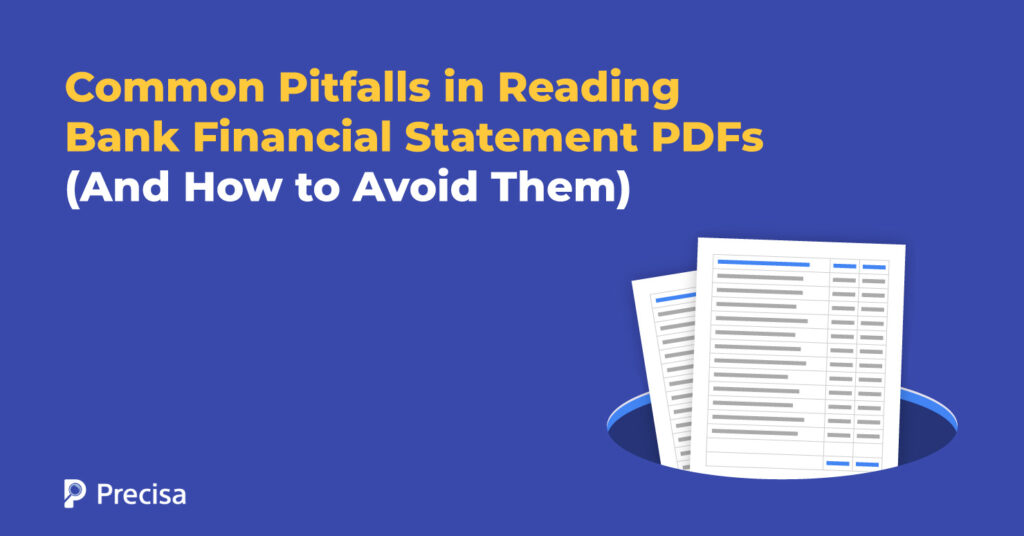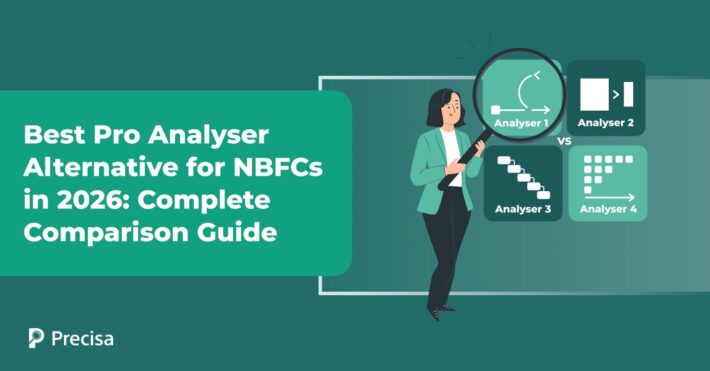Common Pitfalls in Reading Bank Financial Statement PDFs (And How to Avoid Them)

Financial statements offer insights into the health of an individual or a business. Lenders can extract valuable information from bank financial statement PDFs to aid them in their lending decisions.
Automation has replaced manual analysis of financial statements for many lending businesses, helping reduce the time and effort required to extract, organise, and interpret data accurately. Improved fraud management, rule-based loan approval, data analytics and more are benefits of automated financial statement analysis.
However, a few repetitive issues need to be addressed to maintain the importance of financial statement analysis. Let’s find out what they are.
Bypassing Common Pitfalls in Reading Bank Financial Statement PDFs

Analysing bank financial statement PDFs involves examining the statements to gain insight into an organisation’s economic health. The analysis helps lenders assess the creditworthiness and repayment capacity of the borrower and decide whether to sanction a loan.
Below, we focus on five common drawbacks and how to avoid them:
1. Inaccurate Understanding of Financial Ratios
Ratio analysis offers a quick overview of a company’s profitability, liquidity, and efficiency. It examines the relationships between different numbers in financial statements and helps lenders compare a company’s performance with others.
Ratio analysis makes sense only when considered in the context of the industry norms; analysing ratios with the appropriate context offers an accurate picture of the company’s health. Ratio analysis relies heavily on historical data and ignores the current conditions.
Tips to Avoid the Pitfall
- When analysing ratios, lenders must compare them with the appropriate benchmarks (factor in the company size and the right industry).
- Focusing on recent trends and market conditions and management’s perspective can help deal with the challenge of historical data
- The bank statement analyser from the Precisa assigns a credit score based on the borrower’s creditworthiness. The score is calculated based on the borrower’s capacity to repay the loan based on red flags and other factors and helps lenders make objective, data-driven choices.
2. Neglecting Footnotes and Disclosures
Footnotes in financial reporting are explanatory notes that offer additional information and may affect how the financial statements are interpreted. They provide context and details behind the figures presented in the main parts of the financial statements.
Footnotes and disclosures include crucial information about contingent liabilities, accounting standards and more, which provide context for the figures in the bank financial statement PDFs. Not considering these footnotes can result in inadequate analysis.
Tips To Avoid The Pitfall
- Lenders should focus on the footnotes and look for explanations regarding any significant variations in numbers compared to previous years.
- Find out about the contingent liabilities and pending litigation and understand how these will impact the company’s financial health.
- Lenders should read all disclosures on credit and market risk and liquidity risk management.
3. Quality of Underlying Data
Financial statement analysis is as good as the data provided by the company in its statements. The accuracy of the analysis depends on the genuineness of the financial statements. Even though the statements are audited, they are not always foolproof. Sometimes, they may not reflect the company’s real economic health.
A well-known example of this challenge is the Enron scandal, which came to light in October 2001. The company manipulated the financial records to hide vast accumulated debt due to unsuccessful deals and projects.
Tips to Avoid the Pitfall
- Using multiple reliable sources to cross-check the data can help avoid the challenge of analysis based on inaccurate data.
- Lenders should use only data from externally audited financial statements for the analysis.
- Using automated tools helps extract data from various sources, such as financial statements, databases, or APIs, and integrate it into a single platform, reducing the chances of inconsistencies.
4. Inaccurate Interpretation of Cash Flow Statements
Cash flow analysis is an integral part of financial analysis. Common areas of misinterpretation, like equating net income with cash flow, overlooking the impact of changes in working capital on cash flows and ignoring the timing of cash inflows and outflows could result in an inaccurate assessment of an organisation’s credit health.
Misinterpreting cash flows during financial statement analysis can lead to incorrect conclusions about a company’s financial health.
Tips to Avoid the Pitfall
- It is essential to remember that the net income is calculated on an accrual basis and includes non-cash expenses like depreciation.
- Analyse the changes in current assets and liabilities to gauge their impact on cash flow.
- Cash flow statements should be studied carefully to understand the timing and magnitude of cash flows.
5. Ignoring Qualitative Factors
Bank financial statement PDFs provide quantitative information, which offers valuable insights for analysis. Various qualitative factors contribute to the success or failure of an organisation, some of which are often not captured in the financial statements.
Overlooking non-financial factors like employee morale, brand reputation, or technological innovation does not provide an accurate picture of the company’s overall health.
Tips to Avoid the Pitfall
- Integrating qualitative factors in the overall analysis provides a more comprehensive picture.
- Lenders should assess the management’s track record and experience and the company’s corporate governance practices.
- Evaluate the sustainability and scalability of the company’s business model.
To Sum It Up
Lenders can use bank financial statement PDFs to get valuable insights that help them make informed and objective decisions. Automated bank financial statement analysis improves the efficiency and accuracy of the outcome and enables lenders to mitigate their risks.
Being mindful of the pitfalls allows lenders to take proactive steps to avoid them and get a comprehensive view of the organisation’s financial health.
Precisa offers a cloud-based Bank Statement Analyser, an advanced tool that empowers lenders to make better, more informed decisions. The tool validates data to weed out duplicate records, incomplete or missing data, and faulty processing of record fields for accurate analysis.



